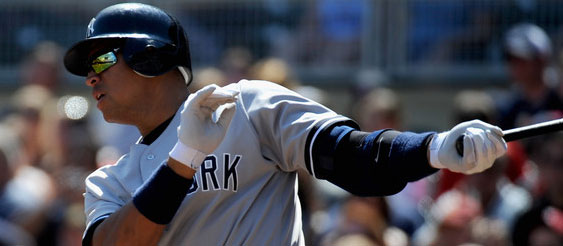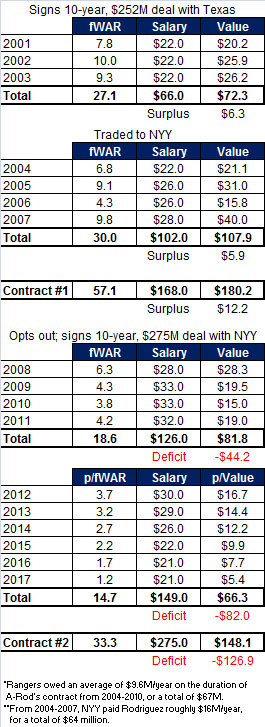
In the aftermath of last month’s Albert Pujols deal, one couldn’t help but constantly see Alex Rodriguez’s name brought up in connection with the contract, as the dollar amount of Pujols’ contract was the second-highest in history after Alex’s second 10-year pact. Several WAR-based analyses were immediately conducted in an attempt to determine just how good Pujols would have to be justify the length and size of the deal, which led me to wonder just how much A-Rod has actually been worth over the duration of his mega-deals, and what he could be worth over the remainder of the six years he still has on his current Yankee contract.

The Angels will be heartened to know that Alex lived up to his contract and then some during its first three years, providing $72.3 million of value to Texas while being paid $66 million. Unfortunately for the Rangers, despite all of that value the remainder of the roster was largely ineffective, as the team finished in last place in the AL West in each of those three seasons.
Determined to rid themselves of Alex’s albatross of a contract, the Rangers first tried to trade A-Rod to the Red Sox in December 2003, only to have the MLBPA step in and put the kibosh on the deal as Alex was willing to take a pay cut to get the deal done. Two months later they found a match with the Yankees, who flipped strikeout-prone Alfonso Soriano and Joaquin Arias for a 28-year-old A-Rod and $67 million of the $186 million remaining on Alex’s deal.
From 2004-2007, the Yankees paid Alex approximately $16 million a year, or $64 million, and got $107.9 million of value out of him, good for a $43.9 million surplus. Even when you factor in the portion of his salary that Texas paid Alex still proved to be worth the money through the first seven years of his deal, putting up $180.2 million in value against $168 million in salary.
Of course, rather then rest on the fact that they nearly doubled the value of their investment during four of the best years of his (or anyone’s) career, the Yankees (not Brian Cashman) re-signed Alex after he famously opted out during the 2007 World Series to another 10-year deal that would keep him in pinstripes through his Age 42 season.
While I am an unabashed A-Rod fan, and am happy he’s still on the team not to mention the fact that they probably don’t win the 2009 World Series without him, it’d be an understatement to say his second deal hasn’t worked out nearly as neatly for the Yankees as his first contract. Through the first four years of the new deal, Alex has been paid $126 million and been worth “only” $81.8 million. It seems weird to decry a player who’s averaged more than $20 million in value during his last four seasons, and we can thank Hank Steinbrenner for that. The good news is that Alex’s $44.2 million deficit is a wash due to the $43.9 million in surplus value the Yankees got out of him during the first four years. Almost.
The bad news is that Alex is still under contract for six more seasons, and if history has taught us anything it’s that time is most unkind to aging ballplayers. On the one hand, one could argue that Alex is a special case, and his preternatural ability to be amazing at baseball will withstand the test of time. Baseball-Reference’s Similarity Scores would seem to support this idea, as Alex’s top comps through Age 35 are Hank Aaron (hit .298/.385/.574 in his Age 36 season), Mel Ott (.308/.411/.499), Frank Robinson (.251/.353/.442) and Willie Mays (.263/.334/.453). That’s some good company, although you’d hope Alex’s Age 36 season is closer to the former two than the latter two.
On the other hand, if Alex the ballplayer does indeed age like everyone else, and we apply a fairly standard -0.5 WAR annual penalty to his performances going forward and assume a continued valuation of roughly $4.5 million per win on the open market (which could of course fluctuate), he would finish out the final six years of his contract providing $66.3 million in value while being paid $149 million. This would give us a total of $148.1 million of value against $275 million in salary over 10 years, or a loss of $126.9 million.
If you want to factor in the $43.9M surplus from the first contract (which includes the $38M from the Rangers), then ultimately one could say the Yankees may end up having overpaid A-Rod by $83 million for his services after all is said and done, but of course that’s but one scenario.
An even grimmer one than I’ve presented here comes courtesy of The Hardball Times’ Oliver projection system. Now this is far from an apples-to-apples comparison, as THT seems to use its own proprietary WAR calculation (for example, they have 2011 A-Rod at 2.3 WAR, while B-Ref has 2.7), but it has Alex actually having a slightly better overall year in 2012 at 2.5 WAR before a steep decline to 1.8 in 2013, followed by 1.1, 0.3, -0.5 and then -1.2 in the last year of his deal. That would give Alex a total value of 4 WAR (or roughly $18 million) over the final six seasons of his deal, which, yikes.
Now the Oliver forecast appears to be pretty extreme — while I think we can expect Alex’s skills to deteriorate to a certain degree, I don’t know about to the point of providing negative value — although it should also serve as something of a cautionary tale. We saw firsthand how rapidly a once-robust offensive performer can decline with Jorge Posada this past year alone, and though Posada was never consistently an A-Rod-caliber hitter, he did post several seasons that wouldn’t look out of place on the back of Alex’s baseball card. That said, I still feel confident that Alex will at least outperform his seemingly worst case scenario Oliver projections, and I also think he can turn in more than 14.7 WAR over the next six seasons after all is said and done.
Leave a Reply
You must be logged in to post a comment.